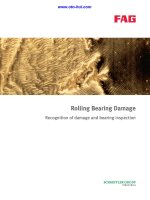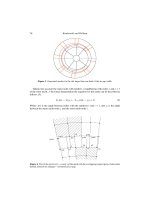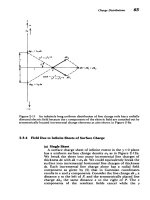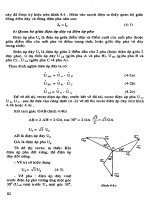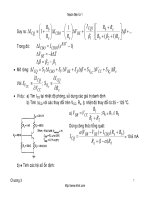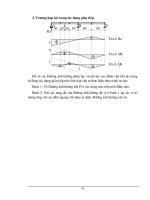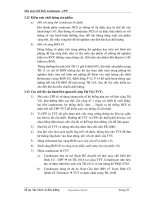Rolling Bearing Damage 2009 Part 10 ppsx
Bạn đang xem bản rút gọn của tài liệu. Xem và tải ngay bản đầy đủ của tài liệu tại đây (378 KB, 7 trang )
– Roughness measurements down to
one hundredth of a micrometer,
fig. 104
– Inspection of form and position toler-
ances on form measuring systems
(FMS) and coordinate measuring
machines, also for very irregularly
formed construction parts such as
cast steel housings, fig. 105
– Inspection of bearing clearances and
radial runout of individual parts
FAG 62
104: Roughness measuring chart with
characteristic values
105: Coordinate measuring machine
Other means of inspection at FAG
Geometric measuring
4.2 Lubricant analyses and
lubricant inspections
FAG has laboratories and test floors
for inspecting the quality and suitability
of lubricants for rolling bearing applica-
tions.
Laboratory analyses of lubricants
from failed bearings frequently supply
the decisive information necessary to
clarify the cause of failure. The main in-
spection means are:
– Amount and type of contamination
present
• solid, fig. 106a
• liquid (humidity)
– Use of anti-oxidants
– Ageing, fig. 106b
– Change in viscosity
– Additive content (reduction/degrada -
tion)
– Oil-soap relation in greases
– Determination of type and class of
lubricant, e.g. evidence of lubricant
mixture during relubrication,
fig. 106b
The extraction of a suitable lubricant
sample is an essential prerequisite for re-
liable information based on the lubricant
inspection (see section 2.2). The origin
of contaminants can almost always be
determined from the results of their
analyses. A direct indication of possible
measures to stop wear, for example, can
therefore be obtained just as conclusions
regarding suitable oil change intervals or
a fresh grease supply can be drawn from
information on the general condition of
an oil or grease after a certain running
period.
63 FAG
Other means of inspection at FAG
Geometric measuring
106 a: Inspection of contaminants, ICP-AES Analysis
106 b: FT-IR Analysis of lubricant
Element Lambda Factor Offset low low high high
min max min max
Cobalt 228,616 1,673 268 962 415 179515 107157
Manganese 257,610 1,318 -76 -121 -34 67816 51496
Chromium 267,716 1,476 381 669 195 76696 51688
Copper 324,754 0,834 -471 80 660 2297 3316
Molybdenum 281,615 1,073 -17 89 99 47781 44543
Nickel 231,604 1,778 4 114 62 38487 21640
Vanadium 311,071 0,937 -37 5 45 64228 68560
Tungsten 400,875 0,742 -16 4 26 14129 19053
Silicon 251,611 2,173 310 509 92 2385 955
sample: solids in contaminated lubricant method: steel 1 M(3)
Co Mn Cr Cu Mo Ni V W Si
x .0107 0.636 1.412 0.185 0.797 0.271 .327 .002 0.359 %
s .0004 .0002 .011 .0002 .0032 .0063 .0007 .0099 .0006
sr 4.11 0.67 0.03 1.18 0.40 2.31 0.22 57.44 0.06
FAG OEM und Handel AG Research and Development
OHT-L-1/Lubricating Greases
and Org. Analytic, W. Wolz
Product preservative oil, new (above, green) Cont. IR nr.: 901495/901496
preservative oil, used (below, red) Date of check: 03.05.1990
WE/Batch: sample 26.04.1990/- / dito after Oxbomb 31.05.1990
Date of receipt: 26.04.1990 Nr. of scans 4
Path length: 67.98 µm / 68.04 µm Resolution 2 cm–1
Device: Perkin Elmer FT IR 1725 X Checker Ch. Hassiotis
new oil
used oil
New lubricants, on which there are
no findings concerning their suitability
for lubricating rolling bearings, are also
used in special cases of applications.
FAG test rigs have been developed to
check the properties of such greases and
oils. They have also been standardized
and adopted by the lubricant industry
for testing new products, fig. 107.
FAG 64
107: Test rig for determining lubricant quality
Other means of inspection at FAG
Lubricant analyses and lubricant inspections
4.3 Material inspection
The condition of the material of all
bearing parts is of decisive importance if
the bearings are to be fully efficient.
Indeed, bearing damage is very seldom
due to material or production faults, fig.
11, but a material inspection can provide
important information in cases of doubt.
In a number of cases changes in the ma-
terial condition are due to unexpected
bearing application conditions.
The main inspections in this area are:
– Inspection of hardness and more
seldom, tensile strength or notch im-
pact bending strength
– Metalographic assessment of structure
– Making zones of unpermissible
heating visible by etching the contact
areas
– Crack inspection by means of ultra-
sound or eddy current
– Radioscopic measuring of retained
austenite
– Inspection of material cleanliness
– Material analysis
In addition to determining material
faults, these inspections can provide in-
formation for example on unpermissible
slippage (sliding heat zones, fig. 108) or
unexpectedly high operating tempera-
tures (change in structural parts during
operating and dimensional changes as a
result).
65 FAG
Other means of inspection at FAG
Material inspections
108: Section of heat influence zone
4.4 X-ray micro structure analysis
The radioscopic investigation of the
lattice structure (cf. Measuring retained
austenite in section 4.3) also allows one
to draw very important conclusions on
the residual stress "frozen" in the ma-
terial and the stressing on which it is
based. It is applied to determine with
good approximation the actual load of
bearings after operation. This may be
particularly crucial in damage cases
where the actual load situation cannot
be attained by calculation. The specific
raceway stress, however, must have
reached a level of about 2,500 N/mm
2
for a longer period since it is only above
this load that the plastic deformation of
the material lattice occurs and only then
can it be tested and quantified by means
of X-ray diffraction, fig. 109. You could
refer to the booklet "Schadenskunde in
Maschinenbau", Expert Verlag 1990, for
example, under "Schadensuntersuchung
durch Röntgenfeinstructuranalyse" for a
detailed report on determining residual
stress and calculating stress. We have
provided a brief summary for you below.
The residual stress present in small
areas (size a few square millimeters sur-
face, 1/100 millimeters in depth) can be
calculated back from the lattice expan-
sion measured by means of X-ray diffrac-
tion. Measuring is carried out layer by
layer for the different depths below the
raceway of a bearing ring by an electro-
chemical surface discharge. A pattern as
in fig. 110 is then obtained. From the
whole deformation depth and from the
depth where stress is greatest, the maxi-
mum external load can be deduced on
the one hand and, on the other hand,
the share of possible sliding stress in the
raceway. This is a vital contribution to-
wards the search for damage causes, par-
ticularly if the values measured deviate
greatly from those expected on the basis
of calculations.
FAG 66
Other means of inspection at FAG
X-ray micro structure analysis
109: X-ray micro structure analysis equipment
110: Residual stress pattern as attained from an X-ray micro structure analysis;
high tangential force portion in outer ring 6207E, no increased stress in
reference bearing 6303E
0
AR 6306E
AR 6207E
Depth below the surface in mm
Residual stress in N/mm
2
200
0
-200
-400
-600
-800
-1 000
-1 200
0,2 0,4 0,6 0,8 1
4.5.Scanning electron microscope
investigations (SEM)
When investigating damage a stereo-
microscope is usually applied in addition
to the naked eye to detect the individual
failure causes. However, the damage-
related details are sometimes tiny. Due
to the relatively large wave length of
visible light, the definition of the image
of light-optical projections is limited.
With the usual surface uneveness of
damaged rolling bearing raceways,
photos can only be enlarged sharply de-
fined up to 50 fold. This obstacle in
light-optical inspection of surfaces can
be bypassed with the very short-wave
electron beam in a scanning electron
microscope (SEM). It makes the detec-
tion of details several thousand times
greater, fig. 111.
The scanning electron microscope is
therefore a vital aid for the visual inspec-
tion of raceways damaged by wear or the
passage of current, fractured areas, for-
eign particle indentations, and material
inclusions, figs. 112a, b and c.
67 FAG
Other means of inspection at FAG
Scanning electron microscope investigations
112: SEM photos of surface structure in
various sizes.
a: raceway ok
b: hard foreign particle indenta-
tions
c: fatigue damage commencing
111: Scanning electron microscope
a
b
c
It is also possible to make the socalled
electron beam micro analysis when using
spectrometers together with the SEM. It
inspects the material composition in the
volume range of approx. 1 micron
3
. This
helps to determine the origin of foreign
particles still stuck in the cage pockets of
a bearing, figs. 113a and b. Other appli-
cations with it include the inspection of
coatings or of reaction layers on the
contact areas or the examination of
material compositions in the micro area.
FAG 68
Other means of inspection at FAG
Scanning electron microscopic inspection
113 b: Material composition of foreign particles
113: Micro analysis of foreign particles
a: Foreign particles in cage crosspiece
dark = iron
bright = aluminium oxide
